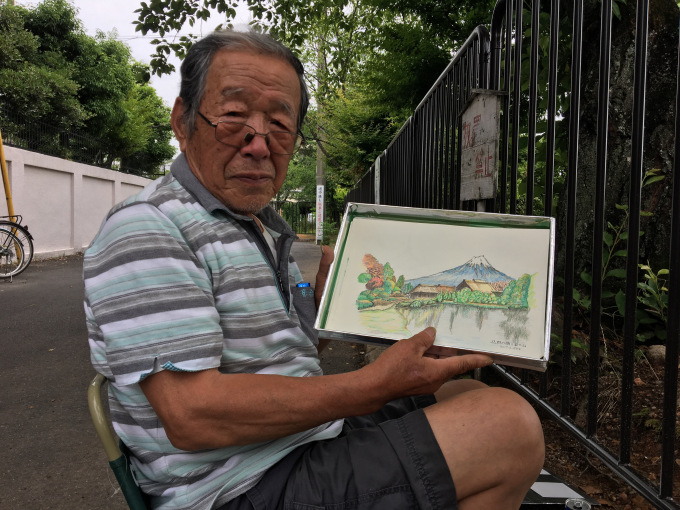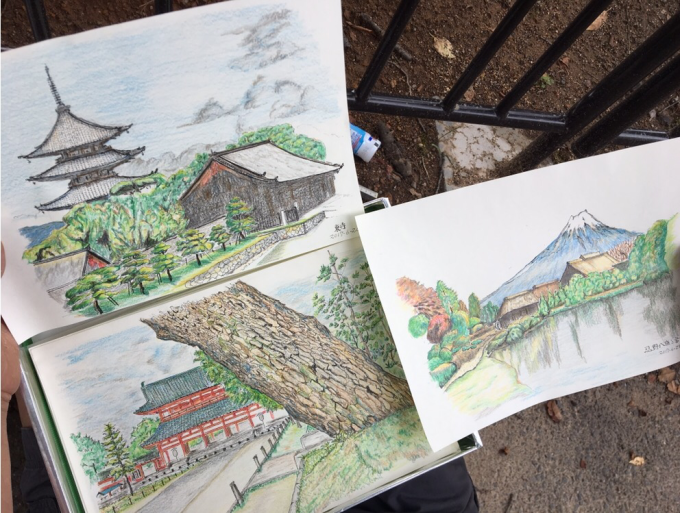WiK Competition Organiser Karen Tawarayama runs a blog which investigates the lives of ordinary Kyoto people. The following interview is extracted from a longer piece which can be found here. There are now six illustrated pieces altogether on her blog, which looks sure to grow into a rather special resource about the life of people in the ‘real Kyoto’ rather than the tourist one – two cities which overlap but do not coincide. (Her blog site incidentally has recently changed from Squarespace to WordPress, with the new address being kyotofaces.wordpress.com. For an introduction to Karen, see here and for a previous item about Kyoto Faces click here.)
**********************

“Why did you choose this location to sketch today?”
I chose this location because my friends and I swam in this body of water when we were children. We all joined the local Tousuikai Swimming Club. There were bars to block off both ends where the water is flowing in a river on either side, and there was even a diving board right in the center. There were long planks of wood that we would stand on and jump off. All of the neighborhood kids belonged to the club, and we all wore red swimming caps. The caps were all marked with our swimming level: 2, 3, etc… There was a boat that went from here, all the way down the river, to Heian Shrine. I swam here a whole lot. Now I’m seventy-seven years old. That was about fifty years ago. I sure made a lot of mischief around here when I was a high school student.
The Kamo River is down the street. When there was a typhoon, some materials, such as planks of wood, would break off from here and there. We would play on top of them and send them floating off down the river when we were done, and we’d get in trouble with the Kyoto City Officials.
I’m the fourth generation of my family to live here in Kyoto. My father worked for the prestigious Shimadzu Coorporation. My grandfather was a candy-maker, craftily using scissors to create shapes like rabbits, etc. His shop was in the Gion area, in a place that Geisha would often frequent.
“What is a big difference between past and present Kyoto?”
The difference between Kyoto then and now is that now, there are so many more rules. You can’t enter there; You can’t swim there. There were so many things we could do in those days. Now it’s a society of prohibitions. Today’s children are inside using computers, playing games. It’s just a different time. Before, we used to run, climb to the top of Mount Daimonji. If the children play outdoors these days, the neighbors get upset and scold them. There are open places to play, but there are still many things you can’t do there. It’s almost just like taking a walk. It’s the same within the wide Imperial Palace Grounds. There are so many prohibited activities… even sparklers aren’t allowed.
In my junior high days, there were big fireworks held along the Kamo River, between Sanjo Street and Oike Street, I think. They were on a huge scale. And once, one of the buildings in the Imperial Palace Grounds caught on fire from a fallen ember, and then that event was prohibited. I feel sorry for today’s children.
“When did you start sketching?”
Three years ago, my wife developed lung cancer and was admitted to Kyoto University Hospital. She was released and then re-admitted over a one-and-a-half year period. During that time, the cancer spread from her lungs into her brain. She was getting weaker and weaker, and we were told by the doctors that the treatment she was undergoing would no longer have any effect. So, it came to that point. I continued to care for her at home, and it was very expensive. It was my first such experience as a human being, and I feel the first time my eyes were really open to my wife. Then, she passed away, and I felt for the first time as if I had the realization of what makes us human.
After her passing, I had been at home doing absolutely nothing for about a week, and my son recommended to me that I should take up a hobby. I thought, even if I’m not good at it, I’ll start sketching pictures here and there which really reflect who I am. These will be for me. For my memories. I’ll draw all of the places I went with my wife. My wife and I took a lot of walks together. To Heian Shrine, for example. She also loved snowy scenes, so I drew a picture of the snow in Ohara.
I’ve been drawing for about two-and-a-half years now, and the process has become really enjoyable for me. I’ve started thinking, “Hey, I’ve done pretty well on this one,” and my daughter compliments me on ones she feels are especially pretty. Or she comments, “Oh, that’s the place you went with Mom.” Most of the drawings are places we went together, so I’ve been connecting this hobby with my happy memories. That was the starting point for it all.
I wanted to take my wife on one last vacation so we drove by small car, all the way to Mount Fuji, and stayed by Lake Kawaguchi. I knew it would be the last time, but she had been dreaming of going there. We went by car because her bones had become so weak by the cancer treatment, and she needed to use a wheelchair. That was my last chance to make memories for her. It took about eight hours to get there, but I’m glad I did it.

